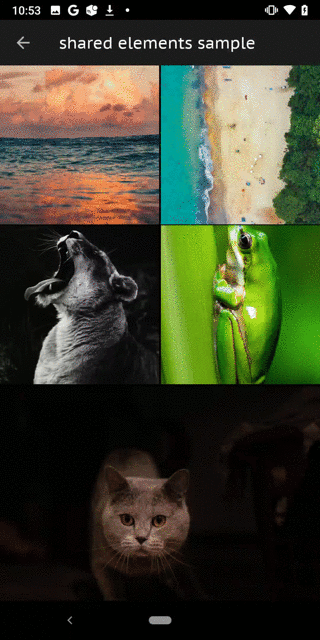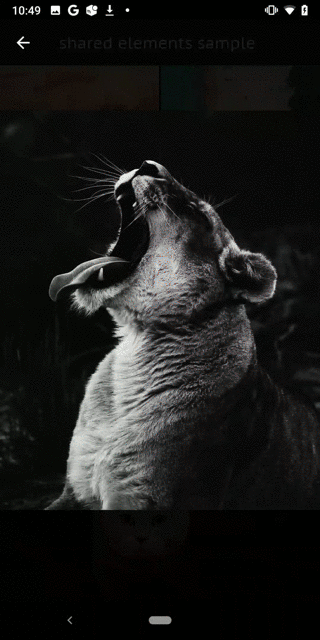Loupe is an ImageView Helper for Android that supports pinch-to-zoom and swipe-to-dismiss gesture.
Loupe provides modern image viewer ui by super simple code. You can implement the Twitter-like image viewer in 10 minutes.
Project build.gradle
repositories {
mavenCentral()
}App build.gradle
dependencies {
implementation 'io.github.igreenwood.loupe:loupe:1.2.2'
// optional
implementation 'io.github.igreenwood.loupe:extensions:1.0.1'
}You can check the released version here.
Let's think about simple Master/Detail Flow.
(If the user taps the image in MasterActivity, it will open DetailActivity and full screen image shows.
Once the user swipe down the image in DetailActivity, it will close DetailActivity and back to MasterActivity.)
If you do not use Shared Element Transition, you don't need to any additional code to MasterActivity.kt.
1. In your activity_detail.xml, wrap your full screen ImageView with ViewGroup like FrameLayout (except for ViewPager).
This step is required for avoiding touch handling conflicts. Set the background color to this ViewGroup, if you want to change alpha of background whenever the view position changed.
<FrameLayout
android:id="@+id/container"
android:layout_width="match_parent"
android:layout_height="match_parent"
android:background="@color/black_alpha_87">
<ImageView
android:id="@+id/image"
android:layout_width="match_parent"
android:layout_height="match_parent" />
</FrameLayout>The first argument is your ImageView and the second argument is the direct parent of the ImageView.
val loupe = Loupe.create(imageView, container) { // imageView is your ImageView
onViewTranslateListener = object : Loupe.OnViewTranslateListener {
override fun onStart(view: ImageView) {
// called when the view starts moving
}
override fun onViewTranslate(view: ImageView, amount: Float) {
// called whenever the view position changed
}
override fun onRestore(view: ImageView) {
// called when the view drag gesture ended
}
override fun onDismiss(view: ImageView) {
// called when the view drag gesture ended
finish()
}
}
}Now your ImageView supports pinch-to-zoom and swipe-to-dismiss gesture 😄
When using Shared Element Transition, the code is little more complicated.
1. Add app/res/transition/smooth_transition.xml to your project. (Change the file name to what you want.)
<?xml version="1.0" encoding="utf-8"?>
<transitionSet xmlns:android="http://schemas.android.com/apk/res/android"
android:transitionOrdering="together"
android:duration="375"
>
<changeBounds/>
<changeImageTransform/>
</transitionSet>2. Set the transition xml file(smooth_transition.xml) to your AppTheme in styles.xml and add settings for Shared Element Transition.
<resources>
<style name="AppTheme" parent="Theme.AppCompat.NoActionBar">
<item name="android:windowSharedElementsUseOverlay">true</item>
<item name="android:windowSharedElementEnterTransition">@transition/smooth_transition</item>
<item name="android:windowSharedElementExitTransition">@transition/smooth_transition</item>
</style>
</resources>3. In your activity_detail.xml, wrap your ImageView with ViewGroup like FrameLayout (except for ViewPager).
This step is required for avoiding touch handling conflicts.
Set the background color to this ViewGroup, if you want to change alpha of background whenever the view position changed.
<FrameLayout
android:id="@+id/container"
android:layout_width="match_parent"
android:layout_height="match_parent"
android:background="@color/black_alpha_87">
<ImageView
android:id="@+id/image"
android:layout_width="match_parent"
android:layout_height="match_parent" />
</FrameLayout>4. In MasterActivity.kt, set the transition name to the target ImageView and pass the shared element information via Bundle.
targetImageView.transitionName = "your_transition_name"
startActivity(
DetailActivity.createIntent(
this@MasterActivity
),
ActivityOptionsCompat.makeSceneTransitionAnimation(
this@MasterActivity,
targetImageView,
targetImageView.transitionName
)
)5. In DetailActivity.kt, call postponeEnterTransition() in onCreate(). After the image loaded, set the same transition name to the target ImageView, and call startPostponedEnterTransition().
6. In DetailActivity.kt, create Loupe instance after the image has loaded and implement OnViewTranslateListener .
The first argument is your ImageView and the second argument is the direct parent of the ImageView.
In default, Loupe uses vertical translate animation on dismissing the ImageView.
If you want to use Shared Element Transition, set useFlingToDismissGesture to false.
val loupe = Loupe.create(imageView, container) { // imageView is your ImageView
useFlingToDismissGesture = false
onViewTranslateListener = object : Loupe.OnViewTranslateListener {
override fun onStart(view: ImageView) {
// called when the view starts moving
}
override fun onViewTranslate(view: ImageView, amount: Float) {
// called whenever the view position changed
}
override fun onRestore(view: ImageView) {
// called when the view drag gesture ended
}
override fun onDismiss(view: ImageView) {
// called when the view drag gesture ended
finishAfterTransition()
}
}
}If you want to use Loupe with ViewPager, see the sample program.
In default, Loupe uses vertical translate animation on dismissing the ImageView.
If you want to use Shared Elements Transition, set useFlingToDismissGesture to false.
| Vertical Translate Animation | Shared Elements Transition |
|---|---|
 |
 |
If you want to execute some code while swipe-to-dismiss gesture, use OnViewTranslateListener.
The code something like this.
val loupe = Loupe.create(imageView, container) {
useFlingToDismissGesture = false
onViewTranslateListener = object : Loupe.OnViewTranslateListener {
override fun onStart(view: ImageView) {}
override fun onViewTranslate(view: ImageView, amount: Float) {}
override fun onRestore(view: ImageView) {}
override fun onDismiss(view: ImageView) {}
}
}For more details, see the sample program.
Loupe is just a helper of the ImageView.
You can use Loupe with any image loader libraries.
If you use with the image loader library, it would be better that initialize Loupe after the image loading has finished.
With Glide, something like this.
Glide.with(imageView.context).load(url)
.listener(object : RequestListener<Drawable> {
override fun onLoadFailed(
e: GlideException?,
model: Any?,
target: Target<Drawable>?,
isFirstResource: Boolean
): Boolean {
return false
}
override fun onResourceReady(
resource: Drawable?,
model: Any?,
target: Target<Drawable>?,
dataSource: DataSource?,
isFirstResource: Boolean
): Boolean {
val loupe = Loupe.create(image, container) { // initialize Loupe after the image loading has finished
onViewTranslateListener = object : Loupe.OnViewTranslateListener {
override fun onStart(view: ImageView) {}
override fun onViewTranslate(view: ImageView, amount: Float) {}
override fun onRestore(view: ImageView) {}
override fun onDismiss(view: ImageView) {}
}
}
return false
}
}
).into(imageView)The customizable parameters is below.
Loupe.create(image, container) {
// max zoom(> 1f)
maxZoom = 5.0f
// duration millis for dismiss animation
dismissAnimationDuration = 250L
// duration millis for restore animation
restoreAnimationDuration = 250L
// duration millis for image animation
flingAnimationDuration = 250L
// duration millis for double tap scale animation
scaleAnimationDuration = 375L
// duration millis for over scale animation
overScaleAnimationDuration = 375L
// duration millis for over scrolling animation
overScrollAnimationDuration = 250L
// view drag friction for swipe to dismiss(1f : drag distance == view move distance. Smaller value, view is moving more slower)
viewDragFriction = 1.0f
// drag distance threshold in dp for swipe to dismiss
dragDismissDistanceInDp = 96
dismissAnimationInterpolator = DecelerateInterpolator()
restoreAnimationInterpolator = DecelerateInterpolator()
flingAnimationInterpolator = DecelerateInterpolator()
doubleTapScaleAnimationInterpolator = AccelerateDecelerateInterpolator()
overScaleAnimationInterpolator = DecelerateInterpolator()
overScrollAnimationInterpolator = DecelerateInterpolator()
doubleTapZoomScale = 0.5f // 0f~1f
minimumFlingVelocity = 1500f
}You can try parameters with the sample program.
Supported on API Level 21 and above.
-dontwarn com.igreenwood.loupe**
-keep class com.igreenwood.loupe** { *; }
-keep interface com.igreenwood.loupe** { *; }
Loupe extensions makes your code simpler. (Developed by @adrianolc 🎉)
dependencies {
implementation 'com.igreenwood.loupe:loupe:LOUPE_VERSION'
implementation 'com.igreenwood.loupe:extensions:EXTENSIONS_VERSION'
}val loupe = createLoupe(imageView, container) {
useFlingToDismissGesture = false
setOnViewTranslateListener(
onStart = { hideToolbar() },
onRestore = { showToolbar() },
onDismiss = { finishAfterTransition() }
)
}Issei Aoki - i.greenwood.dev@gmail.com
If you are using our library, please let me know your app name 😄
The MIT License (MIT)
Copyright (c) 2020 Issei Aoki
Permission is hereby granted, free of charge, to any person obtaining a copy
of this software and associated documentation files (the "Software"), to deal
in the Software without restriction, including without limitation the rights
to use, copy, modify, merge, publish, distribute, sublicense, and/or sell
copies of the Software, and to permit persons to whom the Software is
furnished to do so, subject to the following conditions:
The above copyright notice and this permission notice shall be included in all
copies or substantial portions of the Software.
THE SOFTWARE IS PROVIDED "AS IS", WITHOUT WARRANTY OF ANY KIND, EXPRESS OR
IMPLIED, INCLUDING BUT NOT LIMITED TO THE WARRANTIES OF MERCHANTABILITY,
FITNESS FOR A PARTICULAR PURPOSE AND NONINFRINGEMENT. IN NO EVENT SHALL THE
AUTHORS OR COPYRIGHT HOLDERS BE LIABLE FOR ANY CLAIM, DAMAGES OR OTHER
LIABILITY, WHETHER IN AN ACTION OF CONTRACT, TORT OR OTHERWISE, ARISING FROM,
OUT OF OR IN CONNECTION WITH THE SOFTWARE OR THE USE OR OTHER DEALINGS IN THE
SOFTWARE.





